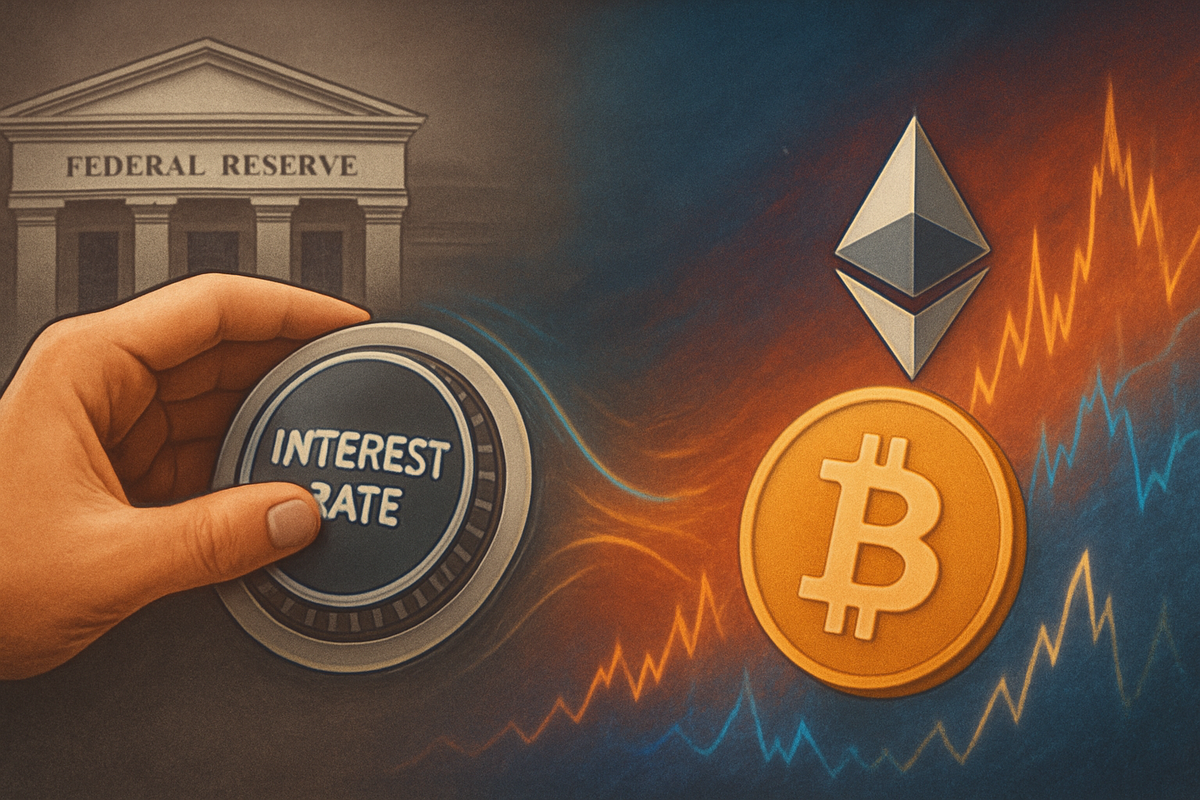
The cryptocurrency market, once heralded as a decentralized haven immune to traditional financial forces, now finds itself inextricably linked to the decisions emanating from the Federal Reserve. As of late 2025, the Fed's delicate balancing act between taming persistent inflation and fostering economic stability is sending palpable ripples through the digital asset landscape, manifesting in heightened volatility, significant shifts in liquidity, and a profound recalibration of investor behavior. This intricate relationship underscores a maturing market, where macroeconomic signals from the world's most powerful central bank directly dictate the ebb and flow of digital wealth.
The immediate implications are clear: every Federal Open Market Committee (FOMC) statement, every shift in interest rate projections, and every nuance from Fed Chair Jerome Powell's commentary can trigger swift and often dramatic price movements in Bitcoin, Ethereum, and the broader altcoin market. Investors are grappling with an environment where "higher-for-longer" interest rate narratives clash with intermittent rate cuts, creating an unpredictable backdrop that demands constant vigilance and a deep understanding of monetary policy's far-reaching grasp.
The Fed's Hand on the Crypto Lever: A Detailed Chronicle
The past few years have meticulously illustrated the Federal Reserve's profound influence on the cryptocurrency market. Following an aggressive series of interest rate hikes in 2022 designed to combat soaring inflation, the crypto market experienced a significant downturn, with Bitcoin's price plummeting over 75% from its November 2021 peak. This period of quantitative tightening (QT) drained liquidity from the financial system, making riskier assets like cryptocurrencies less attractive as safer, yield-bearing traditional assets gained appeal.
A brief respite and a glimmer of optimism emerged in 2023 as the Fed paused its rate hikes, offering some support to digital assets. This was followed by a more significant shift in the latter half of 2024, when the Fed initiated a series of rate cuts, lowering short-term rates three times in September, November, and December, bringing the federal funds rate to 4.25%-4.50%. While these cuts typically signal a "risk-on" environment, the market's reaction was often tempered by cautious forward guidance from the Fed. For instance, despite Bitcoin reaching over $106,000 in mid-December 2024, it experienced a notable pullback in Q1 2025, attributed to ongoing macroeconomic uncertainties and the imposition of new U.S. trade tariffs.
The "higher-for-longer" narrative resurfaced strongly in mid-2025. In May and June, the FOMC held interest rates steady, citing persistent inflation and hinting at only one rate cut for the remainder of the year—a significant reduction from earlier projections. This stance effectively delayed capital inflows into risk assets and strengthened the U.S. dollar, typically a bearish signal for Bitcoin. The Fed did deliver a 25-basis-point rate cut in September 2025, but the crypto market's reaction was largely muted, as the move was already priced in. Chair Powell's subsequent comments about "twin risks" – potential for higher inflation due to tariffs and a slowing labor market – further fueled cautious sentiment. Most recently, in October 2025, another 25-basis-point cut brought rates to 3.75% to 4%. However, the release of the October meeting minutes on November 19, 2025, revealed deep divisions among Fed officials regarding the future pace of easing, citing "two-sided risks." This uncertainty led to Bitcoin extending its decline below $89,000, its lowest level since April, and a significant drop in market expectations for a December rate cut, accompanied by substantial outflows from crypto ETFs.
Corporate Fortunes in the Fed's Shadow
The Federal Reserve's monetary policy significantly influences the fortunes of public companies operating within or closely tied to the cryptocurrency ecosystem. Companies with substantial Bitcoin holdings, cryptocurrency exchanges, and mining operations are particularly susceptible to the Fed's interest rate decisions and liquidity adjustments.
For companies like MicroStrategy (NASDAQ: MSTR), which has made significant strategic investments in Bitcoin, a "higher-for-longer" interest rate environment or periods of quantitative tightening can be particularly challenging. As Bitcoin's price faces downward pressure due to reduced liquidity and a stronger U.S. dollar, the value of MicroStrategy's primary asset declines, directly impacting its balance sheet and investor sentiment. Conversely, periods of monetary easing and increased liquidity could provide a substantial tailwind, boosting the value of their holdings and potentially their stock price.
Cryptocurrency exchanges such as Coinbase Global (NASDAQ: COIN) also feel the direct impact. When the Fed tightens monetary policy, leading to lower trading volumes and reduced investor appetite for risk, Coinbase typically experiences a decrease in transaction fees, which form a substantial portion of its revenue. A more volatile, downward-trending market can also lead to fewer new users and reduced engagement. Conversely, a "risk-on" environment driven by Fed easing often translates to higher trading activity, increased platform usage, and improved financial performance for exchanges.
Furthermore, cryptocurrency mining companies like Riot Platforms (NASDAQ: RIOT) and Marathon Digital Holdings (NASDAQ: MARA) are affected by both the price of Bitcoin and the cost of capital. Higher interest rates make it more expensive to borrow money for expanding mining operations or upgrading equipment. When Bitcoin prices are depressed due to Fed tightening, the profitability of mining operations can decrease, leading to potential revenue shortfalls and pressure on their stock valuations. A more accommodating monetary policy, however, could lower borrowing costs and potentially boost Bitcoin prices, creating a more favorable operating environment for these energy-intensive businesses. The broader macroeconomic environment shaped by the Fed thus acts as a critical determinant of these companies' operational viability and market performance.
Wider Significance: A New Era of Interconnectedness
The profound impact of the Federal Reserve's monetary policy on cryptocurrency markets signifies a pivotal moment in the evolution of digital assets, marking a new era of interconnectedness with traditional finance. This relationship challenges the early narrative of crypto as a completely uncorrelated, anti-establishment asset class, instead positioning it as a highly sensitive barometer of global liquidity and risk appetite. The increasing correlation between major cryptocurrencies like Bitcoin and traditional stock markets, particularly tech stocks, means that macroeconomic headwinds that affect equities often cascade into the crypto space, defying previous notions of crypto acting as a complete hedge against traditional market volatility.
This dynamic also has significant ripple effects across the broader financial ecosystem. As institutional adoption of cryptocurrencies continues to grow, the Fed's actions not only influence direct crypto investors but also impact financial institutions, hedge funds, and corporations that have integrated digital assets into their portfolios or business models. For instance, banks exploring crypto services or asset managers offering crypto-related products must now factor in the Fed's stance more prominently in their risk assessments and strategic planning. Competitors in the fintech space, whether traditional or crypto-native, are all operating under the same overarching monetary conditions, leading to intensified competition for capital and market share during periods of tightening.
From a regulatory and policy perspective, the Fed's influence further highlights the growing need for clear and comprehensive regulatory frameworks for digital assets. The central bank's actions, while not directly regulating crypto, implicitly shape the environment in which these assets operate, impacting their perceived stability and utility. This interplay could accelerate discussions around stablecoin regulations, central bank digital currencies (CBDCs), and broader consumer protection measures, as policymakers seek to mitigate systemic risks that might arise from a highly volatile, yet increasingly integrated, crypto market. Historically, periods of significant monetary policy shifts have always led to re-evaluations of asset classes; for crypto, this means a continued push towards greater transparency and accountability to align with established financial norms.
What Comes Next: Navigating the Macroeconomic Tides
Looking ahead, the cryptocurrency market faces a complex and evolving landscape, largely shaped by the Federal Reserve's ongoing efforts to manage inflation and economic growth. In the short term, the market is likely to remain highly sensitive to incoming economic data, particularly inflation reports and labor market statistics, which will directly inform the Fed's future policy decisions. The deep divisions among Fed officials regarding the pace of future easing, as revealed in the October 2025 FOMC minutes, suggest that continued volatility and uncertainty will be the prevailing themes. Investors should anticipate sharp reactions to any hawkish or dovish shifts in rhetoric from Fed officials, as well as to any unexpected economic surprises.
In the long term, the anticipated end of quantitative tightening, potentially by December 1st, according to Binance Research, could signal a significant shift in the macroeconomic backdrop. The cessation of QT could transform a persistent liquidity headwind into a potential tailwind for Bitcoin and other risk assets, injecting more capital into the financial system and potentially fostering a more favorable environment for digital asset appreciation. However, this potential tailwind will be counterbalanced by the Fed's cautious stance on future rate cuts, with projections currently indicating a slow and measured approach to easing.
Strategic pivots will be essential for both investors and crypto firms. Investors may need to adopt more nuanced strategies, potentially favoring assets with stronger fundamentals or those less sensitive to short-term liquidity shifts, while also closely monitoring the U.S. dollar's strength. Crypto companies may need to focus on sustainable business models, cost efficiency, and diversification of revenue streams to weather periods of reduced market activity. Emerging market opportunities could arise in areas like decentralized finance (DeFi) that offer real-world utility or in projects that are less dependent on speculative trading volumes. However, the overarching challenge will remain the Fed's "twin risks" – the persistent threat of inflation versus the slowing labor market – which could lead to scenarios ranging from a gradual, controlled easing to a more prolonged period of higher rates, each with distinct implications for the crypto market's trajectory.
Comprehensive Wrap-Up: A Maturing Market Under the Fed's Gaze
The intricate relationship between the Federal Reserve's monetary policy and the cryptocurrency markets has undeniably matured, moving beyond mere correlation to a state of profound interdependence. The key takeaway from the past year, leading up to November 2025, is that the era of crypto operating in an isolated financial silo is firmly over. Fed decisions on interest rates, quantitative easing, and tightening are now fundamental drivers of asset volatility, liquidity flows, and investor sentiment across the digital asset space. From the aggressive rate hikes of 2022 to the cautious cuts of 2024 and the "higher-for-longer" narratives of 2025, each policy shift has left an indelible mark on crypto valuations and trading dynamics.
Moving forward, the market will continue to be an arena where macroeconomic forces play a dominant role. The recent uncertainty surrounding future rate cuts, coupled with significant outflows from crypto ETFs, underscores the prevailing cautious sentiment among institutional and retail investors alike. While the potential end of quantitative tightening offers a glimmer of hope for future liquidity, the Fed's ongoing vigilance against inflation means that a rapid return to an to an era of abundant, cheap capital is unlikely.
The lasting impact of this period will be a more integrated and, arguably, more disciplined cryptocurrency market. Investors are now compelled to understand traditional economic indicators and central bank communications with the same rigor they apply to on-chain metrics. What investors should watch for in the coming months are the Fed's updated economic projections, any shifts in its inflation outlook, and, crucially, the timing and magnitude of future interest rate adjustments. These signals will continue to be the primary compass guiding the volatile, yet undeniably significant, journey of digital assets within the broader financial world.
This content is intended for informational purposes only and is not financial advice






